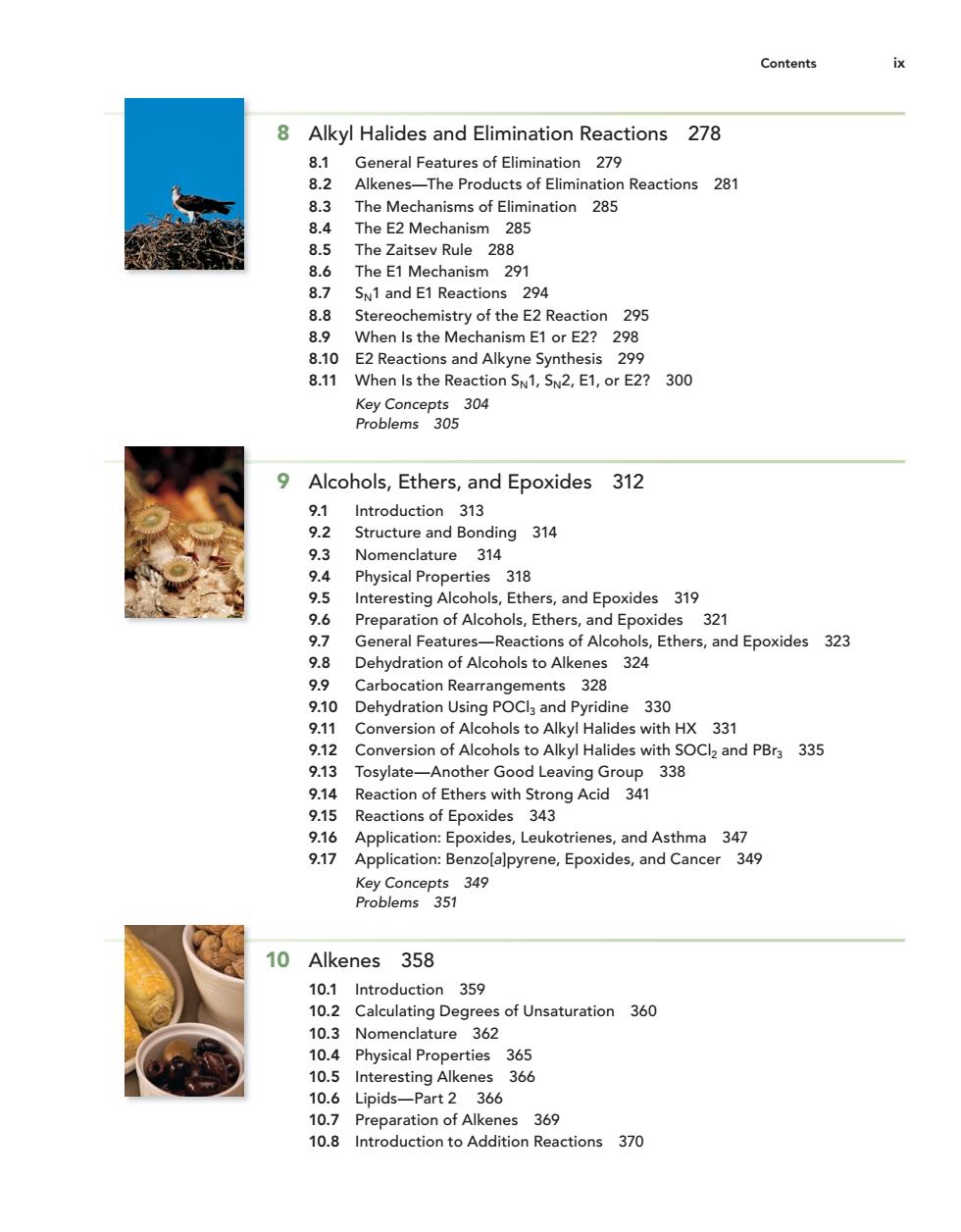正在加载图片...

Contents 8 Alkyl Halides and Elimination Reactions 278 82 General Features of Elimination 279 Alkenes-The Products of Elimination Reactions 281 8 The Mechanisms of Elimination 285 8.4 The E2 Mechanism 285 8.5 The Zaitsev Rule 288 8.6 The E1 Mechanism 291 8.7 SN1 and E1 Reactions 294 9 Stereochemistry of the E2 Reaction 295 When Is the Me mE1orE2?298 8.10 E2 Reactions and Alky thesis 299 811 When Is the Read ction SN1. 2,E1,0rE2?300 Pro ems Alcohols,Ethers,and Epoxides 312 Introduction 313 Structure and Bonding 314 9.3 Nomenclature 314 5 Physical Properties 318 Interesting alcohols.Ethe and Ep oxides 319 Preparatio of Alcohols.Ethe d ER ides 321 ral Featur -Rea .Ethers s,and Epoxides 323 Dehydration of Alco A 324 arbocation Rearrangemen 34 9.10 Dehydration Using POCl3 and Pyridine 330 9.11 Conversion of Alcohols to Alkyl Halides with HX 331 9.12 Conversion of Alcohols to Alkyl Halides with SOCl2 and PBr3 335 9.13 Tosvlate-Another Good Leaving Group 338 9.14 Reaction of Ethers with Strong Acid 341 9.15 Reactions of Epoxides 343 9.16 Application:Epoxides.Leukotrienes.and Asthma 347 9.17 Application:Benzo[alpyrene,Epoxides,and Cancer 349 349 Alkenes 358 101 Introduction 359 10.2 Calculating Degrees of Unsaturation 360 10.3 Nomenclature 362 10.4 Physical Properties 365 10.5 Interesting Alkenes 366 10.6 Lipids-Part 2 366 10.7 Preparation of Alkenes 369 10.8 Introduction to Addition Reactions 370Contents ix 8 Alkyl Halides and Elimination Reactions 278 8.1 General Features of Elimination 279 8.2 Alkenes—The Products of Elimination Reactions 281 8.3 The Mechanisms of Elimination 285 8.4 The E2 Mechanism 285 8.5 The Zaitsev Rule 288 8.6 The E1 Mechanism 291 8.7 SN1 and E1 Reactions 294 8.8 Stereochemistry of the E2 Reaction 295 8.9 When Is the Mechanism E1 or E2? 298 8.10 E2 Reactions and Alkyne Synthesis 299 8.11 When Is the Reaction SN1, SN2, E1, or E2? 300 Key Concepts 304 Problems 305 9 Alcohols, Ethers, and Epoxides 312 9.1 Introduction 313 9.2 Structure and Bonding 314 9.3 Nomenclature 314 9.4 Physical Properties 318 9.5 Interesting Alcohols, Ethers, and Epoxides 319 9.6 Preparation of Alcohols, Ethers, and Epoxides 321 9.7 General Features—Reactions of Alcohols, Ethers, and Epoxides 323 9.8 Dehydration of Alcohols to Alkenes 324 9.9 Carbocation Rearrangements 328 9.10 Dehydration Using POCl3 and Pyridine 330 9.11 Conversion of Alcohols to Alkyl Halides with HX 331 9.12 Conversion of Alcohols to Alkyl Halides with SOCl2 and PBr3 335 9.13 Tosylate—Another Good Leaving Group 338 9.14 Reaction of Ethers with Strong Acid 341 9.15 Reactions of Epoxides 343 9.16 Application: Epoxides, Leukotrienes, and Asthma 347 9.17 Application: Benzo[a]pyrene, Epoxides, and Cancer 349 Key Concepts 349 Problems 351 10 Alkenes 358 10.1 Introduction 359 10.2 Calculating Degrees of Unsaturation 360 10.3 Nomenclature 362 10.4 Physical Properties 365 10.5 Interesting Alkenes 366 10.6 Lipids—Part 2 366 10.7 Preparation of Alkenes 369 10.8 Introduction to Addition Reactions 370 smi75625_fm_00i-xxxiv.indd ix 11/17/09 11:21:19 AM